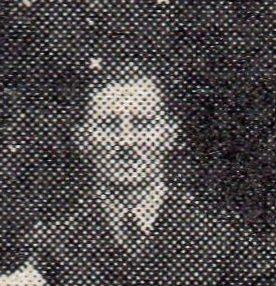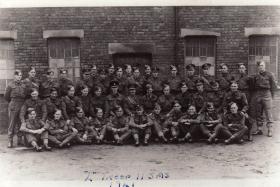Stanley Wandless was from Gloucester and was commissioned into the Argyll and Sutherland Highlanders.
Still a Second Lieutenant, in late 1941, he volunteered for ‘Special Service’ and joined the 11th Special Air Service Battalion (Parachute Wing), where he was assigned to ‘L’ Troop, which was almost completely made up of former Grenadier Guardsmen, under the command of Capt. PE Bromley-Martin.
On the conversion of the unit to become the 1st Parachute Battalion he was originally assigned as the Platoon Commander of 8 Platoon, but when this was disbanded he took over as 7 Platoon Commander.
Having travelled by sea, to take part in Operation ‘Torch’ in North Africa, on 16 November 1942 the 1st Parachute Battalion undertook a parachute operation in Tunisia to secure the area to the south of Mateur, to assist the advance of the 1st Army. After landing they were used as ground troops.
A great deal of patrolling was necessary, as the British forces were very thin on the ground.
Patrol Reports were attached to the Battalion War Diary:
Report on Patrols – Lieutenant. Wandless.
18th November 1942. In a defensive position at Beja. Received the following orders from Lieutenant Colonel Hill - proceed with my platoon by transport to the west side of Medjez-el-Bab where I would meet Major Inglefield of the Derbyshire Yeomanry, under whose orders I would be. Then, supported by armoured cars of the DY, I would take up a defensive position covering the bridge of Medjez-el-Bab, preferably on the east bank of the river.
Arrived at Medjez-el-Bab at 1700 hours and met Major Inglefield who gave me the following information - about 300 Germans were in position on the high ground east of the town. French troops were in positions of defence, but there had been no fighting. German officers visited the town daily under a flag of truce, and had twice demanded to occupy it. A French liaison officer explained that the attitude of the Commandant at Medjez-el-Bab was that he was trying to delay the Germans by parley until a British force arrived and so far resisted the German demands by threatening to fight. The Germans apparently wanted to come in peacefully and avoid incidents with the French.
On being informed that one platoon and some armoured cars comprised the total British force, the French Commandant tactfully refused permission to enter the town and after a further conference I was ordered by Major Inglefield to withdraw to Oued Zarga, where I arrived at approx 2100 hours.
19th November 1942. I received orders through Major Inglefield to take up a position in reserve astride the road at Dir el Gueria (J4934). Arrived at this position at about 1000 hours and contacted French officers who were constructing defensive positions. Soon after the area was dive bombed and machine gunned, French AA guns retaliated and we opened fore on low flying aircraft with Brens and saw the tracer bullets enter three of the aircraft. Took up a position on the right of the French positions on the high ground at Sidi Ahmed (J504341).
At about 1300 hours received a message from Colonel Hill to proceed to a position on the north bank of the river (559316) and contact a battery of 6 pdr anti-tank guns of the US Army and arrange for their local protection. Arrived at about 1600 hours and dug defensive positions. No enemy seen.
20th November 1942. 0400 hours message arrived to Battery Commander to evacuate position immediately. We withdrew riding on the limbers as far as a point 5 kilometres north of Oued Zarga, where I was ordered by an American Colonel to debuss. I then found R Company and stayed with them and returned to Beja at about 1500 hours.
APPENDIX ‘G’.
Report by Lieutenant Wandless, 7 Platoon, ‘S’ Company.
3rd December 1942. I was ordered to take out a fighting patrol consisting of two sections of No 7 Platoon and one section of LF’s to attack a small number of enemy reported to be occupying Tabouna Farm 5969. As a subsidiary task if time allowed, I was also to patrol to Sidi Bou Aoid 579688. If Tabouna Farm contained no enemy I was to make a thorough search of the place for signs of enemy occupation.
Left Battalion HQ at 2300 hours and proceeded along the track running north east. Crossed stream midway between Tabouna Farm and Sidi Bou Aoid. Crossing difficult because of thick mass of undergrowth which covers the stream on both banks. Reached high ground north of farm and advanced in extended order. Entered farm without opposition. An Arab said the farm belonged to Italians who had gone to Mateur five days ago. Stated there had been no soldiers in the place. We entered and searched the farm buildings and the area around about and found no trace of military occupation.
Completed this task at 0445 hours and gathered patrol together. Left at 0500 hours and proceeded along track to Sidi Bou Aoid and when about 800 yards off Bou Aoid turned off to the right and approached under cover of a plantation and got into the farmyard behind a haystack. Detailed section tasks for clearing area and at 0530 hours entered the farm. Challenged by two German sentries who were shot. Enemy then appeared at various places and were completely surprised and shot up. A number were soon running in the direction of the Mateur road. From reports of section commanders it is estimated 17 enemy were killed or wounded. At 0600 hours as dawn was breaking I decided that time would not allow us to make a thorough search of the farm and I withdrew. Two enemy prisoners, both wounded, could not travel very well and had to be left. Enemy identified as parachutists by their dress and estimated number about 30. They had no arrangements for local protection outside the area of the farm buildings. We had no casualties. Private Reed abandoned his Bren gun and his section and withdrew on his own. Returned to Battalion HQ at 0930 hours.
APPENDIX ‘H’.
11th December 1942. Took out a patrol consisting of No 7 Platoon. Left lines at 1000 hours with the following orders - proceed to Sidi Bou Aoid and try to take some prisoners.
Proceeded via Tabouna Farm. Midway between Tabouna and Sidi Bou Aoid heard two blank rounds fired from the direction of Tabouna Farm. Approached Bou Aoid from north west and when about 100 yards from the farm I fell over a trip wire and a can rattled. L/Corporal soon after hit another wire and exploded a mine which fortunately caused no casualties. Three grenades were then thrown from the right flank landing about 20 yards from the right hand section. Being thus caught in open ground with no cover, withdrew about 300 yards and reformed platoon. MG fire opened up but did not come near us. More grenades were thrown apparently at random, and a gun believed to be an anti-tank gun fired one round from the Farm, which was presumed to be a signal.
Decided that position was probably too strong for a fighting patrol and withdrew a further 800 yards towards Tabouna and laid an ambush hoping a patrol would be sent out. Laid up for one hour. Heard what was thought to be a patrol passing eastwards along south bank of stream. Crossed stream and proceeded to about 500 yards from Tabouna without hearing anything further, and it was then 0530 hours, returned to our lines.
Report on the action at Gué Hill by Lieutenant Wandless.
23rd November 1942. When at approx 497673 I was leading 7 Platoon of S Company, Colonel Hill gave me the following orders - stated that enemy were on the hill point 163 4967 and 7 Platoon would get up on the north eastern side and snipe the enemy on the hill. I gained the foot of the hill on the north east side and deployed the Platoon with 7 Section on the right, 8 in the centre and 9 on the left. Proceeded to climb the hill in extended order and soon came under MG fire from the top of the hill. Moved platoon forward into dead ground and stopped to try and locate positions.
Large numbers of grenades were then thrown down so I sent 7 Section round to the right to create a diversion and moved quickly with the remaining two Sections to the south east side of the hill and proceeded to advance up the hill. On this side there was more cover such as boulders. Soon after we again came under MG fire, this time very heavy and more grenades, but I was able to identify one MG position. Giving this as a target to the nearest Bren gunner, we advanced in short bounds covered by the Bren, until we were within throwing distance of the nearest MG. Threw some grenades and advanced to the top of the hill and immediately gave rapid fire onto the position and then walked forward in line firing as we went. By this time all the enemy on the hill were killed or wounded. Before the final assault I had shouted to 7 Section to come round behind us which they did. They had got pinned down by fire on the right and were working their way to the left when they heard us shouting. There was one casualty, Private Shirley, Platoon Runner, who was hit by a grenade. L/Corporal Colville gave him attention under fire.
There was a MG 34 on a heavy mounting and a Breda LMG on the hill. There were five enemy dead including a German corporal and eight wounded. An Italian corporal who had run away was later taken prisoner. While in the process of consolidating and searching bodies I received an order to withdraw immediately to the road at 494678, subsequently returning to Sidi N’Sir.
He was awarded the Military Cross for his actions in the North African campaign, 1942 – 1943, announced in the London Gazette on the 11th February 1943.
For conspicuous gallantry and leadership.
On the night of the 23/24 Nov, 42, the Battalion attacked enemy positions in the area B BON MALLANFA (TUNISIA sheet 2 J.5968).
Lieut. WANDLESS and his Pl, were given as their objective an enemy AA Gun at the summit of a very steep hill. As Lieut. WANDLESS’s platoon advanced up the coll it was held up by intense machine gun fire and a hail of hand grenades. The gun was protected by at least a platoon in well prepared positions and four or five machine guns. Lieut. WANDLESS rallied his men who were considerably shaken and led them into the assault with grenades. The entire garrison of the hill was either killed, wounded or captured. This post was only captured by the powers of leadership and extreme courage of Lieut. WANDLESS.
On 3 and 4 Dec, Lieut. WANDLESS was in command of a fighting patrol which raided a German position at DOMAINE DE BOU ACID (TUNISIA Sheet 2 5969).
The patrol succeeded in killing and wounding at least 15 Germans and withdrew without casualties.
Lieut. WANDLESS’s leadership and personal courage has been of the highest order throughout the entire operation and he has taken part in many daylight reconnaissance patrols which have yielded valuable information as to the enemy dispositions.
The son of Albert and Ethel Wandless, of Gloucester; husband of Julie Wandless, of Gosport, Hampshire, he was 27 years old when he was killed on 6 January 1943.
He has no known grave and is commemorated on the Medjez-el-Bab Memorial, Face 34, Tunisia.



Latest Comments
There are currently no comments for this content.
Add Comment
In order to add comments you must be registered with ParaData.
If you are currently a ParaData member please login.
If you are not currently a ParaData member but wish to get involved please register.